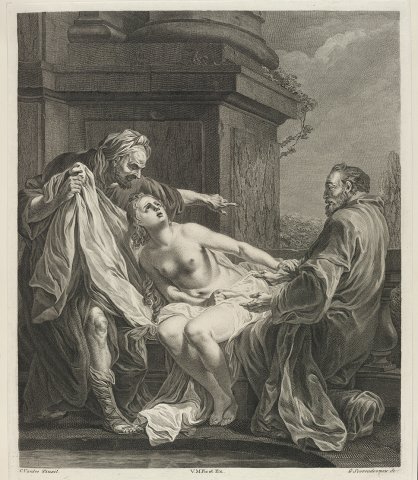The Chaste Susanna - Scorodoumov after Carle Vanloo
Notice précédente Notice n°3 sur 103 Notice suivante
Description
Booklet from the 1765 Salon:
"By the late M. Carle Vanloo, premier Peintre du Roi, Chevalier de son Ordre, Directeur de l'Académie Royale de Peinture & de Sculpture, Directeur de l'Ecole Royale des Elèves protégés.
N° 1. [...]
2. The Graces.
3. The Chaste Susanna.
These two Paintings, of the same size, are 7 feet 6 inches high, by 6 feet 2 inches wide."
Deloynes 8, 107. Critique des peintures et sculptures de messieurs de l'Académie royale. L'an 1765. (anonyme sl), p. 7:
"This painting is one of Sallon's most beautiful & striking [8]. Susanne in the midst of the two Old Men, is in an attitude that characterizes with great truth, shame mingled with despair at finding herself exposed to the impudicities of the two Old Men she hates to hear about. A criminal passion tempts her to her doom; her virtue protects her from it. In one of the Old Men, there is an air of indignation at finding her unfailing virtue an obstacle: in the other, there is an air of gentleness as she strives to achieve her goal. The arrangement of this painting is pleasing, and the brushwork very meticulous. It attracts all Spectators, & passes for one of his masterpieces."
Deloynes 8, 108. Mathon de la Cour, Lettres a Monsieur ** sur les peintures, les sculptures et les gravures, exposées dans le Sallon du Louvre en 1765, Bauche, 1765, p. 4:
"Carle Vanloo's third painting depicts Susanne. She is a strikingly beautiful woman whose physiognomy [5] & attitude express both anger & fright. While one of the old men parades her beauty with sparkling eyes, the other strives to seduce her with his eloquence. Although this painting is very effective, it is said that Vanloo wanted to repaint the old men.
You must agree, Monsieur, that reputation is a beautiful thing. They say that morals have degenerated. Yet here is a Jewish woman who immortalized herself, over three thousand years ago, for rebuffing two old men. How many French women have there been of whom no mention has been made, and who have resisted kind young men? It's true that these old men tested Susanne with threats, but that's all the more reason not to be listened to: a man who would today resort to this revolting means, would not triumph even over a woman without morals."
Mercure de France, October 1765, p. 148-149:
"Another painting by the same Author & of similar size to the previous one, represents Susanne exposed to the licentious enterprises of two Old Men. The woman's head character is in keeping with the situation; fear, indignation, & hope in Heaven's help are clearly expressed. The body is of great beauty of complexion & design. The two old men group well with the Susanna's figure; they also have expression in their heads: we have heard it said that the Painter himself nevertheless still found something to be desired & that he intended to retouch it, had he lived longer. As this painting is, it produces an effect that has conciliated all the suffrages of the Public, & which has always made it looked at with a marked distinction."
1. Signed below the engraving on the left "C. Vanloo Pinxit.", center "V.M.Picot Ex.", right "G. Scorodoumow Sc."
Under the signatures, the title is in English: "The Chaste Susannah."
Under the title: "London Publ & Sold, Sep.r 20. 1776 by V.M. Picot. N°16 Strand."
2. The painting exhibited at the 1765 Salon is in the Hermitage. It was rolled up in 1922 and can no longer be photographed. This is the counterpart engraving after the drawing by V.-M. Picot, published in 1776.
See Diderot's commentary, Laffont, Bouquins, p. 298-300.
3. Diderot compares Vanloo's painting to the Suzanne by J.-F. de Troy, which he saw at Lalive de Jully's, and which is currently in the Rouen museum (inv. 891-3) as well as to the one by Sébastien Bourdon, seen at Baron d'Holbach's, whose current location is unknown (see link). The description of the third Suzanne alluded to by Diderot corresponds to that of Cesari, seen by Diderot at the Palais-Royal, in the collection of the Duc d'Orléans. This painting, now lost, is known from the engraving (see link). The engraving is also reproduced in Else Marie Bukdahl, Diderot critique d'art, t. I, p. 62.
Search Bnf Estampes among the following call numbers: BnF Est. Db-33 (1-2)-Fol.BnF Est. Za-571 (26)-Boîte pet. fol. 8 pl. SNR-3VAN LOO (Carle), DevériaBnF Est. SNR-1 VA, SNR-3 SCORODOUMOFF Gavrila Ivanovitch.
Technical Data
Notice #000783



